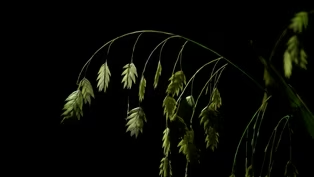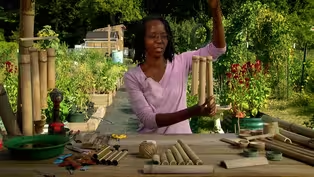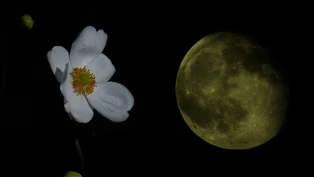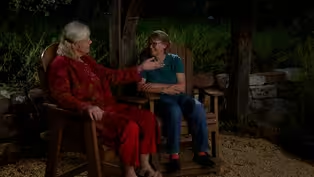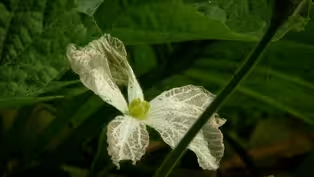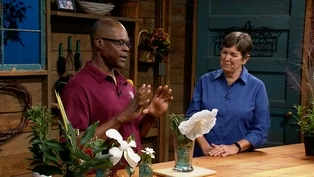Virginia Home Grown
Responsible Landscape Lighting
Clip: Season 25 Episode 7 | 6m 18sVideo has Closed Captions
Learn how to reduce glare and enhance your garden lighting design
Tim Ryan from Lighthouse Design studio visits Peggy to demonstrate landscape lighting tools designed to control light in the garden and discuss the benefits to us, our wildlife and our neighbors when we reduce the overall amount of light in our garden. Featured on VHG episode 2507, September 2025.
Problems playing video? | Closed Captioning Feedback
Problems playing video? | Closed Captioning Feedback
Virginia Home Grown is a local public television program presented by VPM
Virginia Home Grown
Responsible Landscape Lighting
Clip: Season 25 Episode 7 | 6m 18sVideo has Closed Captions
Tim Ryan from Lighthouse Design studio visits Peggy to demonstrate landscape lighting tools designed to control light in the garden and discuss the benefits to us, our wildlife and our neighbors when we reduce the overall amount of light in our garden. Featured on VHG episode 2507, September 2025.
Problems playing video? | Closed Captioning Feedback
How to Watch Virginia Home Grown
Virginia Home Grown is available to stream on pbs.org and the free PBS App, available on iPhone, Apple TV, Android TV, Android smartphones, Amazon Fire TV, Amazon Fire Tablet, Roku, Samsung Smart TV, and Vizio.
Providing Support for PBS.org
Learn Moreabout PBS online sponsorshipWell, Tim, this is exciting because we've got a lot of tools here.
But the first step is understanding how we as gardeners can be more responsible with lighting.
>>And that's really a great question because I know it comes up a lot in conversations nowadays about dark sky concerns and over-lighting gardens.
And so we really do have to be sensitive to those things for sure.
So when it comes to illuminating garden spaces, I am very much pro-lighting as a lighting designer, right?
>>Yes.
>>Of course.
But I also believe that there are ways to do it correctly.
And there are ways that even contractors and lighting guys out there in the industry, right now, even a lot of homeowners, they're doing it incorrectly.
And oftentimes they're over-lighting things much more than they really need to.
>>Less is more.
>>Yeah.
It actually can be.
So lighting, it's very dynamic.
And to be able to bring that into the garden space, it allows our clients to really enjoy those spaces so differently than they do during the day.
It's just a completely different look.
But with all that beauty and with all of that light that we're bringing into the garden, we still have to be responsible about still how we're using that light at night and then allowing the garden a time to rest as well.
>>Exactly.
We need it to rest for the plants, for our wildlife, and for our neighbors.
>>Absolutely.
And speaking of neighbors, when we talk about light fixtures, we've got an array of things here on the table.
And I want to just talk to you briefly about a couple things that we have here.
And I know, within our outdoor lighting spaces, landscape lighting, just so we're clear, landscape lighting really doesn't contribute to the overall sky glow in the sky.
>>Yeah, it's low voltage.
It's very soft.
>>Yeah, it's very, very low.
It is literally- >>It should be.
>>Well, it should be, right?
It should be, right?
But really what we're seeing is the majority of the light that we're seeing in the air is coming from parking lot lights, commercial lighting, where they're using 25 to 75,000 lumens per light.
That's crazy.
Right?
>>That's crazy.
That is crazy.
>>And it's bouncing off structures.
It's coming back up in the air.
And it's particulating in the atmosphere.
But when we talk about landscape light, we're talking about luminaires that are literally a couple hundred lumens.
So by comparison, they just don't have the power to reach up in the atmosphere.
So when we look at a simple thing just to get all nerdy on you with math- >>Slightly, yes.
>>Slightly nerdy, right?
There's a thing called the inverse square law of light.
And so every time you double that light, you have one quarter of the output of light at that distance.
And with landscape lighting luminaires, they just don't have the power to have an effect on night glow.
So really when you talk about landscape lighting, when it's done responsibly and well, it's not gonna contribute.
But we do have to be careful about a few other concerns.
Namely, I'll just name a couple here.
One, insects and birds.
They like to live in the trees.
>>They do.
>>And they wanna sleep too.
Right?
>>Yes.
Yes.
>>And I've even noticed over the year, I've documented over the last 10 to 15 years with LED lights, there are certain varieties of fine-needle evergreens, particularly Picea species of spruce.
>>The spruce.
>>You've got your firs.
Your true cedars, the Cedrus varieties.
I've noticed that they just don't do really well with prolonged periods of light at night.
They will tend to defoliate.
And I've even seen it break off in patterns that follow the light beams.
Crazy.
Right?
>>Fascinating.
That's crazy.
Yeah.
>>So trees and these, they're biological creatures just like us.
In the same way that we have biological rhythms, we need that rest, so do the trees and so do the animals that live in those trees as well.
So being responsible, I always say, when we go to sleep, let your garden go to sleep too.
>>Yeah.
Turn off the lights.
>>Exactly.
>>Yep.
But we gotta talk.
We're getting- >>Let's do this.
Right?
Because we have to be careful about neighbors.
Right?
A nuisance glare, light trespass, it's a thing.
>>Yes.
>>Right?
And we have to watch it in the gardens.
We even see it with coach lights.
We have coach lights that are two bright.
If you're putting candelabra in there that are 300, 400 watts a piece, sometimes you have 12, 1,500 watts that are just blasting out into a neighborhood.
And you really have to watch those things, right?
Even even post lights, but landscape lights, they've been created to have many different features that help us mitigate glare.
And if you'll notice here, with this particular, this is an uplight.
This could be a down light.
It could be used for many different functions, kind of be ubiquitous light.
But you'll notice here particularly, we've got this nice shield.
And what it's doing is it actually helps shield the light source in here.
So as we turn it away on the backside, we're actually hiding and concealing a light source.
And this can actually be turned as we need to, to mitigate glare from a neighbor.
It even comes in longer shields.
You have longer varieties as well too.
And if you need full coverage, you even have full shields too.
So those are great ways to mitigate it just with garden lighting and directional lighting in the landscape.
>>And also we have down-lighting too.
>>We have down-lighting as well.
>>For Walkways and such.
>>Walkways and path lights.
Yep.
These particular little items here, you can put these on a stand or, and they can sit right here on the garden.
But one thing you'll notice about these is they have these great louvers.
And these louvers themselves, they block all the light.
So you're not gonna see that you're looking into that.
>>Which I personally like.
>>Right.
Keep it low, keep it out of sight.
>>Exactly.
I don't like light in my eyes.
>>Exactly.
>>And then over here we have?
>>Yeah.
So this is a bistro.
>>It's kind of fun.
>>Yeah.
So bistro lights are very popular nowadays.
Right?
>>Yes, they are.
>>People love them on their patios.
They like that kind of Italian bistro feel.
Right?
It's nice under dinner.
But one thing you'll notice about these bulls, when they turn them on, they get very, very bright, and they put a lot of light out.
>>I was just at family.
And, boy, did they put out a lot of light.
>>They put out a lot of light.
So some manufacturers, they've created some really neat things.
So one, either put them on a dimmer, bring them all the way down nice and low.
But there's also some great little covers that you can put on these.
And either every other one or every one, and you can hang these out in the garden over your- >>And break up that light.
>>Break it up, and you got a really kind of neat sparkler effect for your garden.
>>Yeah.
Kind of fun.
>>So really neat.
You can add those pieces in there.
But what that does is that helps block a lot of that side glare that goes into your neighbor's property.
And again, we wanna make sure that we're not offending the neighbors, right?
>>Exactly.
And we have seconds left.
So I think this is great information.
We've gotten down-lighting ideas, we've gotten talking about shields and a wonderful way to shield those bistro lights.
And make it more artistic, 'cause that's what lighting is really about.
People forget landscape lighting is, you know, I'll say, making it pretty, using light, very artistically.
>>Experience your garden in a completely different way.
>>Exactly.
So you can look out your window at night and go, "Wow, isn't that pretty?"
>>It should be framed art at night.
>>Exactly.
It should be.
So thank you so much.
>>You're welcome.
Thank you for taking the time to share this.
Clippings: The Nighttime Garden
Video has Closed Captions
Clip: S25 Ep7 | 26m 46s | Explore the garden after dark! (26m 46s)
Video has Closed Captions
Clip: S25 Ep7 | 3m 35s | Calming sounds benefit your garden day or night (3m 35s)
Video has Closed Captions
Clip: S25 Ep7 | 8m 8s | Learn why a day and night cycle is just as important to plants as it is to us (8m 8s)
Video has Closed Captions
Clip: S25 Ep7 | 7m 36s | Visit a garden full of native plants designed to be enjoyed at night (7m 36s)
Night Pollination in the Vegetable Garden
Video has Closed Captions
Clip: S25 Ep7 | 2m 43s | Pollination occurs around the clock in our gardens (2m 43s)
Traditional Moon Garden Plants
Video has Closed Captions
Clip: S25 Ep7 | 6m 23s | Discover the characteristics of plants for night time gardens (6m 23s)
Providing Support for PBS.org
Learn Moreabout PBS online sponsorship

- Home and How To

Hit the road in a classic car for a tour through Great Britain with two antiques experts.












Support for PBS provided by:
Virginia Home Grown is a local public television program presented by VPM
